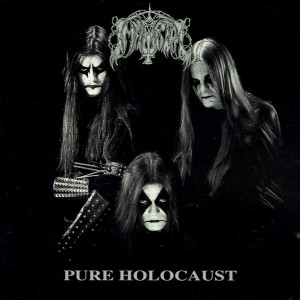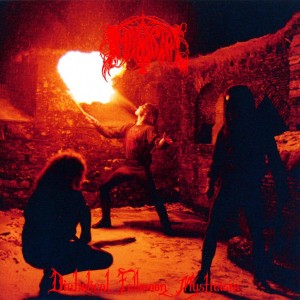 If you bought Immortal’s Pure Holocaust the day it was released, and conceived a child in the ensuing fury, that child would be entering college age today.
If you bought Immortal’s Pure Holocaust the day it was released, and conceived a child in the ensuing fury, that child would be entering college age today.
Our review, written in the year of this CD’s release, captures much of what makes this album great. There are two levels to its greatness, stylistic and content, and while related they cannot be made equivalent.
Stylistically, Immortal on their second album saw the ambient and atmospheric tendencies of black metal and developed them. First, they used lightning fast chaotic drumming that quickly reduced the drums to a background timekeeper, allowing riffs to change phrase freely without being trapped by a specific rhythmic pattern. Second, they upgraded the speed of their guitars and level of reverbed distortion to create a sonic tunnel of sound that from a distance, sounds more like a synthesizer with heavy sustain than a guitar.
In content, Immortal focused what it was to be black metal: naturalism. Like the creatures of nature, or its mercurial winds and storms, black metal is not “rational” and “moral” in the human way, but practical in a way that humans — even non-Christian ones — are often afraid to understand. However, it is a method that a forest creature or great tree would understand, a cross between Zen buddhism and the feral antagonism of a wandering predator. Incorporating previous themes of occultism, tribalism, cosmicism and warfare, Immortal fused the ideas of black metal into a singular concept. As such, this album defies all categories of logic or music, at least the human ones. To a wolf or jaguar, it would make perfect sense.
The result was a blaze of noise and musical terror that swept black metal into its second age. Pure Holocaust, along with Transilvanian Hunger (Darkthrone) the following year, moved black metal beyond the framework established by its 1980s origins in Bathory and Celtic Frost. Now it was something new, something emotional without being self-pitying, some cold and element floating above the clouds. Something that could not be tamed.
While most popular entertainment fades away after only a few years, and with good reason, Pure Holocaust remains strong two decades later. Without having heard it, or any black metal, a music listener can take this off the rack and throw it on the player — even if that means double-clicking — and be lost in an entirely different world, and inspired to try to create that here on modern earth.
No CommentsTags: anniversary, Black Metal, immortal, norway, pure holocaust


